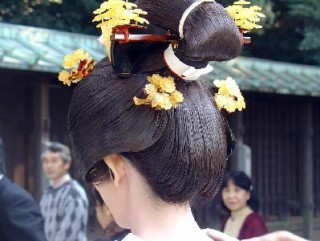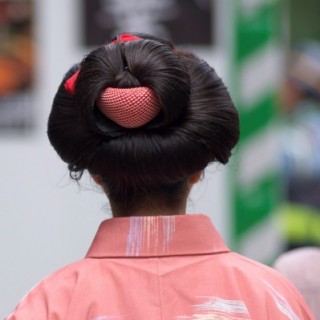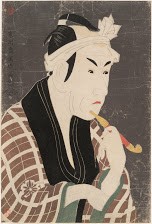 The women’s sophisticated hairstyles we have had occasion to admire in the bijinga are the fruits of a tradition which has developed over the Edo period. It was then that the women discarded the taregami style, which consisted in wearing long hair loose, and switched to the nihongami style being seen with the updo.
The women’s sophisticated hairstyles we have had occasion to admire in the bijinga are the fruits of a tradition which has developed over the Edo period. It was then that the women discarded the taregami style, which consisted in wearing long hair loose, and switched to the nihongami style being seen with the updo.
The shimada, which was a sort of chignon and, therefore, fell within the latter category, might be worn up (taka shimada) the way it was by young ladies, or flattened (tsubushi shimada) and adorned with cloth (uiwata) the way it was by grown-ups, or even split in half like a peach the way it was by the apprentice Geisha (momoware). A typical hairstyle could be referred to as box shimada owing to the peculiar updo look. In the case of yoko-hyogo and gikei, the hairs was so arranged by the use of wax as to form a pair of wing-shaped side bulges.
Taka shimada (the picture is from http://nippon-kichi.jp/article_list.do?kwd=238&ml_lang=en)
Momoware (the picture is from https://www.flickr.com/photos/colodio/4767012869)
There were many other varieties of hairstyles, but the use of the so-called kanzashi (special ornaments) was mandatory in either case. Precious material as gold, silver, jade and gem was adopted for the kanzashi manufacturing, and imaginative forms, as dictated by the time of the year, were taken into account for the design. Those forms were modeled in springtime on the cherry blossom, in the fall on maple leaf and for New Year’s on bode-well dove.
Often, the women’s hairstyles were distinguished by frontal and temporal hair shaving.
Last, the geishas used to sleep on special pillows whereby those overwrought hairstyles would be maintained for a week.
Men’s traditional hairstyle par excellence was the so-called chonmage that differed because the head was shaved except for an oily strand of long hair. Accordingly, some kind of tail was arranged so that it folded down on itself with a view to forming an appropriate tuft on the top of the head. In this way, the samurai helmet remained secure during combat and anyway expressed a well established social standing.
Chonmage (the picture is from https://www.google.com/culturalinstitute/asset-viewer/actor-matsumoto-k%C3%B4shir%C3%B4-4th-as-gor%C3%B4bei-the-fishmonger-from-san-ya-from-the-play-katakiuchi-noriai-banashi-kiri-za/YAGrH-svZyOMYA?hl=it&projectId=art-project)
The picture is from http://www.wikiart.org/en/uemura-shoen/coiffure-oshidori-mage-1935
Copyright © arteingiappone – All rights reserved


